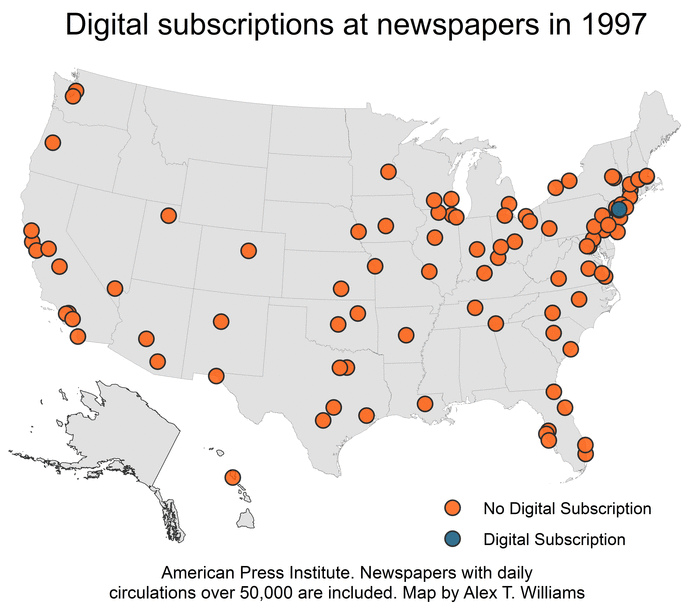In 2009, with advertising revenue steeply declining, news organizations began debating the feasibility of requiring digital subscriptions.
Publications like The Guardian, The New York Times, Time Magazine and The Atlantic published op-eds questioning whether readers would be willing to pay for news online — and whether such subscriptions would cause losses in readership and digital advertising.
Despite these initial concerns, the number of newspapers requiring digital subscriptions has grown rapidly. Consider that in 1997, The Wall Street Journal was the only one requiring a digital subscription among all the newspapers with circulation today over 50,000. By 2010 still only 6 such newspapers were, according to our data. By 2015, 77 of the 98 newspapers with total circulation of 50,000 or more are utilizing a digital subscription model.
As the data illustrates, 2012 was a pivotal year for digital subscription plans. The number of digital subscriptions increased to 52, which signifies that a majority of the newspapers in our dataset were using digital subscriptions by the end of that year. As a consequence, we analyzed how digital subscriptions have changed in the three years since then.
Comparing subscription models in 2012 to 2015, there is a clear trend toward metered models and away from hard models. The number of newspapers using meters increased by 21, freemium models increased by 8; meanwhile, the number of hard models decreased by 4. As we detail later in this report, the success of The New York Times metered model in 2011 likely helped shape this trend.
[chart slug=”subscriptions-13″]The increase in the number of meter and freemium models is mostly attributable to newspapers launching new digital subscriptions. However, several newspapers have also changed from one digital subscription model to another in the past three years.
As meters became increasingly prominent, four newspapers switched to a metered model. The Florida Times Union and the Daily Press in Newport News, Va., switched from a hard model to a metered model. The Omaha World Herald and Boston Globe switched from a freemium model to a metered model. Articulating the common sentiment behind such changes, the editor of The Boston Globe explained in a memo that “the universal belief is that we can bring even more paying readers to the site with a meter.”
At the same time, four newspapers ended their digital subscription plans without replacement: in 2013, the San Francisco Chronicle ended its freemium subscription; in 2013, The Dallas Morning News ended its hard subscription[ref It plans to launch a new digital subscription plan in 2016.]; in 2014, the Philadelphia Inquirer ended its hard subscription. The Albuquerque Journal ended its hard model in 2012 for a different reason: to focus on requiring non-subscribers to complete micro-surveys (a shift detailed in a different chapter).
For newspapers that have continued their digital subscription plans, many have experimented to find the right model. Publishers are often unsure how their audience will react — or what the ideal number of free articles and price points will be.
To illustrate the trend, we compared each newspaper’s initial weekly digital subscription price to the current price. The analysis revealed that 32 newspapers have increased their prices, 21 have kept their prices the same, and 17 have decreased their prices.[ref The original digital subscription price for 7 newspapers could not be determined. These newspapers are excluded from this portion of the analysis]
We also wanted to compare these newspapers based on when they launched their digital subscription models. So we grouped newspapers by the year they launched their model, and calculated the median weekly prices for each group.
By doing so, we see that the initial launch price since 2012 has gone up. Moreover, subscription plans launched recently appear to be higher than previous years.
[chart slug=”subscriptions-14″]Similarly, we compared the initial number of free articles to the current number of free articles.[ref Gannett newspapers do not disclose how many free articles they allow, so their papers are not included in this portion of the analysis] Of the newspapers analyzed, 23 have reduced the number of free articles, 14 have kept it the same, and 5 have increased the number of free articles. Thus, it is rare for a newspaper to increase the number of free articles after their launch date.
The number of free articles has also decreased since 2012. Consider that in 2012, 26 newspapers allowed 15 or more free articles. Today, only 13 newspapers do so, despite there being 21 more metered models.
Share with your network
- How digital subscriptions work at newspapers today
- Early digital subscription models
- Experiments and future models for digital news subscriptions
- Publishers miss opportunity to collect data when registering subscribers
- How digital subscriptions took over the newspaper industry
- Paying for Digital News: The rapid adoption and current landscape of digital subscriptions at U.S. newspapers
You also might be interested in:
Successfully and efficiently marketing your work can be hard, especially for local news teams with limited resources, but marketing yourself to your audience is an essential skill for news organizations to drive revenue and promote sustainability.
As news teams begin thinking about their election coverage plans, it may feel like adding more tasks to an already full plate, with a fraction of the staff and resources they once had. But that doesn’t have to mean figuring out how to do more with less — maybe it’s doing less with less.
We reached out to Danielle Coffey, the CEO of American Press Institute’s parent corporation, the News/Media Alliance, to learn more about the legal fight for news organizations’ rights with AI.



